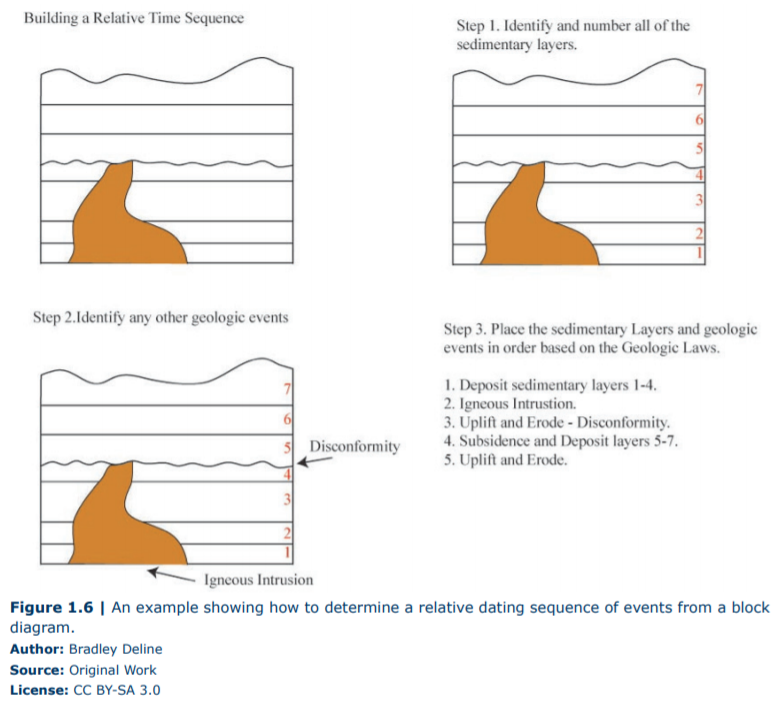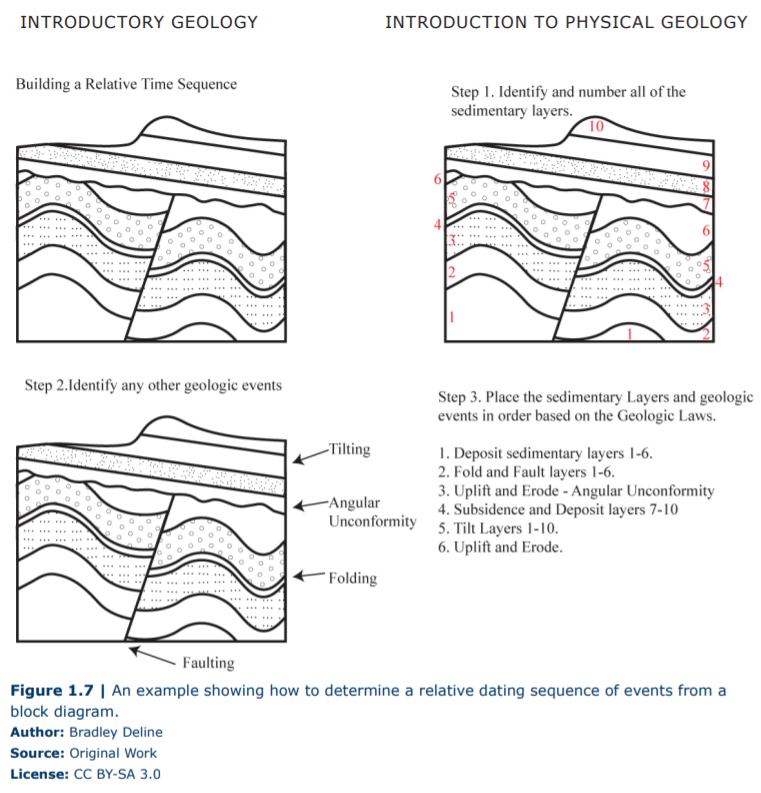1.2: Geologic Time
- Page ID
- 5435
\( \newcommand{\vecs}[1]{\overset { \scriptstyle \rightharpoonup} {\mathbf{#1}} } \)
\( \newcommand{\vecd}[1]{\overset{-\!-\!\rightharpoonup}{\vphantom{a}\smash {#1}}} \)
\( \newcommand{\id}{\mathrm{id}}\) \( \newcommand{\Span}{\mathrm{span}}\)
( \newcommand{\kernel}{\mathrm{null}\,}\) \( \newcommand{\range}{\mathrm{range}\,}\)
\( \newcommand{\RealPart}{\mathrm{Re}}\) \( \newcommand{\ImaginaryPart}{\mathrm{Im}}\)
\( \newcommand{\Argument}{\mathrm{Arg}}\) \( \newcommand{\norm}[1]{\| #1 \|}\)
\( \newcommand{\inner}[2]{\langle #1, #2 \rangle}\)
\( \newcommand{\Span}{\mathrm{span}}\)
\( \newcommand{\id}{\mathrm{id}}\)
\( \newcommand{\Span}{\mathrm{span}}\)
\( \newcommand{\kernel}{\mathrm{null}\,}\)
\( \newcommand{\range}{\mathrm{range}\,}\)
\( \newcommand{\RealPart}{\mathrm{Re}}\)
\( \newcommand{\ImaginaryPart}{\mathrm{Im}}\)
\( \newcommand{\Argument}{\mathrm{Arg}}\)
\( \newcommand{\norm}[1]{\| #1 \|}\)
\( \newcommand{\inner}[2]{\langle #1, #2 \rangle}\)
\( \newcommand{\Span}{\mathrm{span}}\) \( \newcommand{\AA}{\unicode[.8,0]{x212B}}\)
\( \newcommand{\vectorA}[1]{\vec{#1}} % arrow\)
\( \newcommand{\vectorAt}[1]{\vec{\text{#1}}} % arrow\)
\( \newcommand{\vectorB}[1]{\overset { \scriptstyle \rightharpoonup} {\mathbf{#1}} } \)
\( \newcommand{\vectorC}[1]{\textbf{#1}} \)
\( \newcommand{\vectorD}[1]{\overrightarrow{#1}} \)
\( \newcommand{\vectorDt}[1]{\overrightarrow{\text{#1}}} \)
\( \newcommand{\vectE}[1]{\overset{-\!-\!\rightharpoonup}{\vphantom{a}\smash{\mathbf {#1}}}} \)
\( \newcommand{\vecs}[1]{\overset { \scriptstyle \rightharpoonup} {\mathbf{#1}} } \)
\( \newcommand{\vecd}[1]{\overset{-\!-\!\rightharpoonup}{\vphantom{a}\smash {#1}}} \)
\(\newcommand{\avec}{\mathbf a}\) \(\newcommand{\bvec}{\mathbf b}\) \(\newcommand{\cvec}{\mathbf c}\) \(\newcommand{\dvec}{\mathbf d}\) \(\newcommand{\dtil}{\widetilde{\mathbf d}}\) \(\newcommand{\evec}{\mathbf e}\) \(\newcommand{\fvec}{\mathbf f}\) \(\newcommand{\nvec}{\mathbf n}\) \(\newcommand{\pvec}{\mathbf p}\) \(\newcommand{\qvec}{\mathbf q}\) \(\newcommand{\svec}{\mathbf s}\) \(\newcommand{\tvec}{\mathbf t}\) \(\newcommand{\uvec}{\mathbf u}\) \(\newcommand{\vvec}{\mathbf v}\) \(\newcommand{\wvec}{\mathbf w}\) \(\newcommand{\xvec}{\mathbf x}\) \(\newcommand{\yvec}{\mathbf y}\) \(\newcommand{\zvec}{\mathbf z}\) \(\newcommand{\rvec}{\mathbf r}\) \(\newcommand{\mvec}{\mathbf m}\) \(\newcommand{\zerovec}{\mathbf 0}\) \(\newcommand{\onevec}{\mathbf 1}\) \(\newcommand{\real}{\mathbb R}\) \(\newcommand{\twovec}[2]{\left[\begin{array}{r}#1 \\ #2 \end{array}\right]}\) \(\newcommand{\ctwovec}[2]{\left[\begin{array}{c}#1 \\ #2 \end{array}\right]}\) \(\newcommand{\threevec}[3]{\left[\begin{array}{r}#1 \\ #2 \\ #3 \end{array}\right]}\) \(\newcommand{\cthreevec}[3]{\left[\begin{array}{c}#1 \\ #2 \\ #3 \end{array}\right]}\) \(\newcommand{\fourvec}[4]{\left[\begin{array}{r}#1 \\ #2 \\ #3 \\ #4 \end{array}\right]}\) \(\newcommand{\cfourvec}[4]{\left[\begin{array}{c}#1 \\ #2 \\ #3 \\ #4 \end{array}\right]}\) \(\newcommand{\fivevec}[5]{\left[\begin{array}{r}#1 \\ #2 \\ #3 \\ #4 \\ #5 \\ \end{array}\right]}\) \(\newcommand{\cfivevec}[5]{\left[\begin{array}{c}#1 \\ #2 \\ #3 \\ #4 \\ #5 \\ \end{array}\right]}\) \(\newcommand{\mattwo}[4]{\left[\begin{array}{rr}#1 \amp #2 \\ #3 \amp #4 \\ \end{array}\right]}\) \(\newcommand{\laspan}[1]{\text{Span}\{#1\}}\) \(\newcommand{\bcal}{\cal B}\) \(\newcommand{\ccal}{\cal C}\) \(\newcommand{\scal}{\cal S}\) \(\newcommand{\wcal}{\cal W}\) \(\newcommand{\ecal}{\cal E}\) \(\newcommand{\coords}[2]{\left\{#1\right\}_{#2}}\) \(\newcommand{\gray}[1]{\color{gray}{#1}}\) \(\newcommand{\lgray}[1]{\color{lightgray}{#1}}\) \(\newcommand{\rank}{\operatorname{rank}}\) \(\newcommand{\row}{\text{Row}}\) \(\newcommand{\col}{\text{Col}}\) \(\renewcommand{\row}{\text{Row}}\) \(\newcommand{\nul}{\text{Nul}}\) \(\newcommand{\var}{\text{Var}}\) \(\newcommand{\corr}{\text{corr}}\) \(\newcommand{\len}[1]{\left|#1\right|}\) \(\newcommand{\bbar}{\overline{\bvec}}\) \(\newcommand{\bhat}{\widehat{\bvec}}\) \(\newcommand{\bperp}{\bvec^\perp}\) \(\newcommand{\xhat}{\widehat{\xvec}}\) \(\newcommand{\vhat}{\widehat{\vvec}}\) \(\newcommand{\uhat}{\widehat{\uvec}}\) \(\newcommand{\what}{\widehat{\wvec}}\) \(\newcommand{\Sighat}{\widehat{\Sigma}}\) \(\newcommand{\lt}{<}\) \(\newcommand{\gt}{>}\) \(\newcommand{\amp}{&}\) \(\definecolor{fillinmathshade}{gray}{0.9}\)Overview
The amount of time that is involved in the carving of the landscape, the formation of rocks, or the movement of the continents is an important scientific question. Different hypotheses about the age of the earth can essentially change our perspective of the workings of geologic events that molded the Earth. If the geologic time is relatively short, then, catastrophic events would be required to form the features we see on the surface of the earth, whereas a vast amount of time allows the slow and steady pace that we can easily observe around us today.
Geologists have used many methods attempting to reconstruct geologic time trying to map the major events in earth’s history as well as their duration. Scientists studying rocks were able to piece together a progression of rocks through time to construct the Geologic Time Scale (Figure 1.1). This time scale was constructed by lining up in order rocks that had particular features such as rock types, environmental indicators, or fossils. Scientists looked at clues within the rocks and determined the age of these rocks in a comparative sense. This process is called Relative Dating, which is the process of determining the comparative age of two objects or events. For example, you are younger than your parents. It doesn’t matter your age or your parents as long as you can establish that one is older than the other. As time progressed, scientists discovered and developed techniques to date certain rocks as well as the Earth itself. They discovered the earth was billions of years old (4.54 billion years old) and put a time frame to the geologic time scale. This process is called Absolute Dating, which is the process of determining the exact amount of time that has passed since an object was formed or an event occurred.

Both absolute and relative dating have advantages and are still frequently used by geologists. Dating rocks using relative dating allows a geologist to reconstruct a series of events cheaply, often very quickly, and can be used out in the field on a rocky outcrop. Relative dating also can be used on many different types of rocks, whereas absolute dating is restricted to certain minerals or materials. However, absolute dating is the only method that allows scientists to place an exact age to a particular rock.
Relative Time and Geologic Laws
The methods that geologists use to establish relative time scales are based on Geologic Laws. A scientific law is something that we understand and is proven. It turns out that, unlike math, it is hard to prove ideas in science and, therefore, Geologic Laws are often easy to understand and fairly simple. Before we discuss the different geologic laws, it would be worthwhile to briefly introduce the different rock types. Sedimentary rocks, like sandstone, are made from broken pieces of other rock that are eroded in the high areas of the earth, transported by wind, ice, and water to lower areas, and deposited. The cooling and crystallizing of molten rocks form igneous rocks. Lastly, the application of heat and pressure to rocks creates metamorphic rocks. This distinction is important because these three different rock types are formed differently and, therefore, need to be interpreted differently.
The Law of Superposition states that in an undeformed sequence of sedimentary rocks the oldest rocks will be at the bottom of the sequence while the youngest will be on top. Imagine a river carrying sand into an ocean, the sand will spill out onto the ocean floor and come to rest on top of the seafloor. This sand was deposited after the sand of the seafloor was already deposited. We can then create a relative time scale of rock layers from the oldest rocks at the bottom (labeled #1 in Figure 1.2) to the youngest at the top of an outcrop (labeled #7 in Figure 1.2).
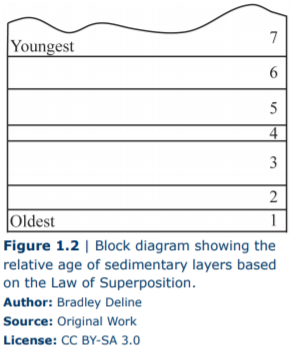
The Law of Original Horizontality states that undeformed sedimentary rock is deposited horizontally. The deposition of sediment is controlled by gravity and will pull it downward. If you have muddy water on a slope, the water will flow down the slope and pool flat at the base rather than depositing on the slope itself. This means that if we see a sedimentary rock that is tilted or folded, it was first deposited flat then folded or tilted afterward (Figure 1.3).

The Law of Cross-Cutting states that when two geologic features intersect, the one that cuts across the other is younger. In essence, a feature has to be present before something can affect it. For example, if a fault fractures through a series of sedimentary rocks those sedimentary rocks must be older than the fault (Figure 1.4).
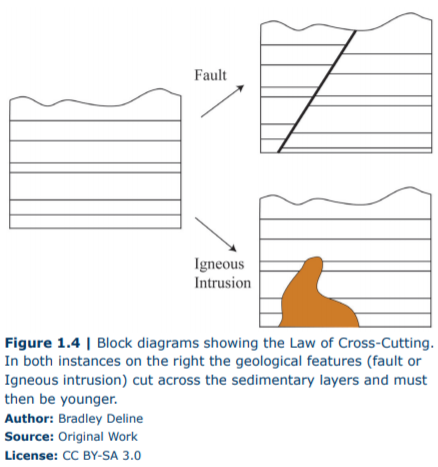
One other feature that can be useful in building relative time scales is what is missing in a sequence of rocks. Unconformities are surfaces that represent significant weathering and erosion (the breakdown of rock and movement of sediment) which result in missing or erased time. Erosion often occurs in elevated areas like continents or mountains so pushing rocks up (called uplifting) results in erosion and destroying a part of a geologic sequence; much older rocks are then exposed at the earth’s surface. If the area sinks (called subsidence), then much younger rocks will be deposited over the top of these newly exposed rocks. The amount of time missing can be relatively short or may represent billions of years. There are three types of unconformities based on the rocks above and below the unconformity (Figure 1.5). If the type of rock is different above and below the unconformity it is called a Nonconformity. For example, igneous rock formed deep in the earth is uplifted and exposed at the surface then covered with sedimentary rock. If the rocks above and below the erosion surface are both sedimentary, then the orientation of the layers is important. If the rocks below the erosion surface are not parallel with those above, the surface is called an Angular Unconformity. This is often the result of the rocks below being tilted or folded prior to the erosion and deposition of the younger rocks. If the rocks above and below the erosion surface are parallel, the surface is called a Disconformity. This type of surface is often difficult to detect, but can often be recognized using other information such as the fossils discussed in the next section.
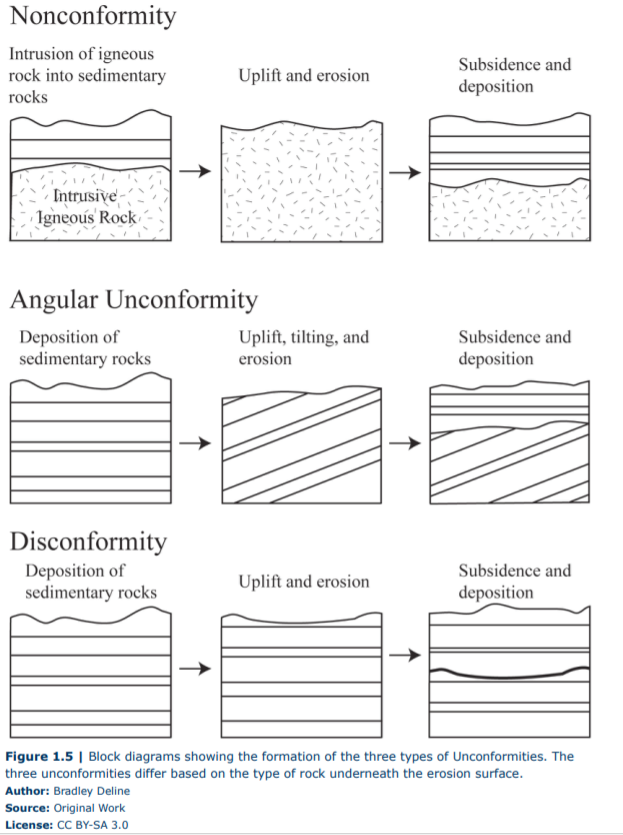
Using these principles we can look at a series of rocks and determine their relative ages and even establish a series of events that must have occurred. Common events that are often recognized can include:
1) Deposition of sedimentary layers,
2) Tilting or folding rocks,
3) Uplift and erosion of rocks,
4) The intrusion of liquid magma, and
5) The fracturing of rock (faulting).
Figures 1.6 and 1.7 show how to piece together a series of geologic events using relative dating.
